Sudden Changes In Your Child'S Behavior May Show Vision Issues; Recognize The Signs That Indicate The Requirement For An Eye Exam To Guarantee Their Healthy And Balanced Advancement
Sudden Changes In Your Child'S Behavior May Show Vision Issues; Recognize The Signs That Indicate The Requirement For An Eye Exam To Guarantee Their Healthy And Balanced Advancement
Blog Article
Content By-Bjerg Waddell
As a moms and dad, you play a critical role in your youngster's health, specifically when it concerns their vision. You might notice particular habits that might signal a demand for an eye test. Squinting, regular eye massaging, or grievances of headaches can be more than just small inconveniences. Comprehending these indicators is vital for your kid's growth. So, what should you search for following? Let's check out the common signs that could suggest a vision issue.
Common Symptoms of Vision Troubles in Kid
When you observe your youngster having problem with daily activities, it could be a sign of vision problems.
Try to find symptoms like squinting, massaging their eyes often, or tilting their head to see much better. If they've difficulty analysis or appear to shed their area commonly, that's one more indication.
You might additionally see them complaining concerning frustrations or experiencing eye pressure after extended periods of reading or utilizing screens.
In addition, if your youngster avoids tasks that call for great vision, like sports or attracting, it deserves taking note of.
Expect any kind of uncommon behavior, as these signs can point to underlying vision concerns that require specialist analysis.
Early detection can make a big distinction in their aesthetic advancement.
Age-Specific Vision Milestones to Monitor
Every moms and dad needs to watch on their kid's vision growth as they expand.
At around 6 months, your infant needs to begin tracking relocating objects. By age 1, they must be able to concentrate on and recognize familiar faces.
In between 2 and 3 years, look for renovations in hand-eye control, like stacking blocks or tossing a sphere.
By age 4, kids should have the ability to identify shapes and shades, and they could start to identify letters.
If click the up coming website page with these turning points, it's necessary to take note. Monitoring their progression helps you catch possible concerns early, ensuring they get the vision treatment they need for a brilliant future.
Stay proactive regarding their vision wellness!
When to Arrange an Eye Exam for Your Child
Checking your child's vision growth is very important, but understanding when to schedule an eye test is equally as essential. The American Academy of Ophthalmology advises your child have their very first eye test at 6 months old.
Afterwards, routine follow-ups at age 3 and once more before they start school. If your child shows indicators of vision concerns-- like scrunching up your eyes, difficulty analysis, or migraines-- don't wait on the next set up visit.
Furthermore, if there's a family history of eye issues, aggressive examinations are necessary. Keep an eye on any kind of changes in their vision or habits, and depend on your reactions.
Normal check-ups can aid catch prospective issues early, ensuring your youngster has the very best opportunity for healthy and balanced eyesight.
website link
To conclude, remaining sharp to your kid's aesthetic habits is necessary for their eye health and wellness. If you notice any type of indications like squinting, eye rubbing, or difficulty with analysis, do not wait to arrange an eye exam. Keep in mind, very early detection can make a considerable difference in their visual growth. Trust your reactions as a parent, and guarantee your youngster gets the treatment they need to prosper. Routine exams can aid keep their eyes healthy and balanced for several years to find.
